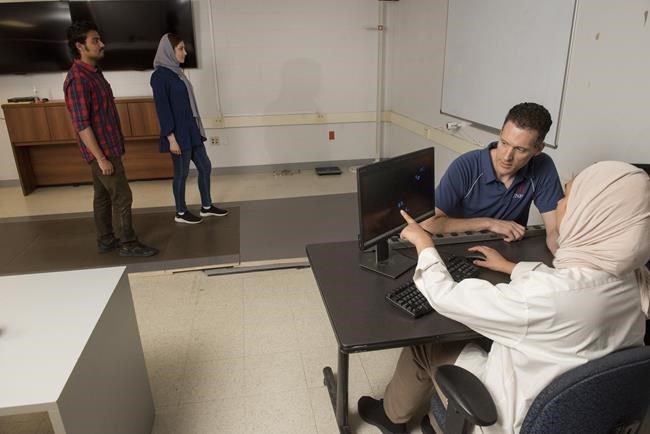Canadians have been unlocking iPhones with their fingerprint since 2013 and are sometimes exposed to facial recognition software before boarding planes, but when it comes to biometric technology, Erik Scheme and Mayssa Rekik are one step ahead.
The associate director of the University of New Brunswick's Institute of Biomedical Engineering and the advanced technologies undergraduate student are part of a team researching what could be the future of biometric security: footsteps.
They installed electronic tiles from P.E.I.'s Stepscan Technologies at their university lab and in the lobby of Fredericton's Cyber Centre to generate a pixel-by-pixel heat map of the pressure distribution of someone’s feet as they walk.
The heel-to-toe data they are capturing will help develop 3D models of the people walking across the tiles and deep learning frameworks that can differentiate one person's walk from another to identify individuals based on gait.
"Whether that's different footwear or carrying different objects or walking in a distracted way, we're trying to build the world's largest data set to make publicly available to the research community, so that we can move this discipline forward," Scheme said.
Interest in biometric technology, which relies on unique physical characteristics like a person's gait, retina, face, heartbeat or voice, is growing in part because most businesses rely on keys, cards, pin codes or personnel to broker access to their spaces or systems.
The methods often leave people rummaging through bags for keys and cards, trying to recall passwords or seeking help from system administrators or security guards, when they're without their means of entry.
Some businesses have tried to do away with these methods by turning to fingerprint and facial scanners, but neither is completely failproof.
Lighting conditions, masks and other accessories can challenge facial scanners, while glove wearers and people wanting to avoid touching additional surfaces in a COVID-19 conscious world pose difficulties for fingerprint-based systems.
"Gait creates an interesting opportunity because, not only is it contactless, you don't even have to stop, you just kind of keep walking and we can authenticate you that way," Scheme said.
"It's a new modality."
Rekik, who has come to Canada from Tunisia for three months to help work on the gait project with the help of research non-profit Mitacs, sees several obvious uses for the technology.
"It would be really helpful for security reasons and it can be used for airports or for entrance to a building," she said.
While banks were once among the most interested sectors in the technology because of the large volumes of sensitive data they handle, enthusiasm around biometric systems has broadly tempered recently, said Imran Ahmad.
The head of technology at law firm Norton Rose Fulbright attributed the pullback to a wave of U.S. litigation and controversies around the use of biometrics.
San Francisco and Oakland, Calif. along with Somerville, Mass. banned the use of facial recognition technology by city agencies in 2019. Many of the bans were sparked by troubles the technology faced in recognizing women and racialized populations.
Ahmad has also seen Illinois, Texas and Washington, where he's found most class actions around biometrics are happening, regulate the collection and use of such data.
"Right now, it's sort of a wait-and-see model, like where is this going to go in Canada?" he said.
Concerns around biometrics are part of why Scheme's team has adopted a careful approach to its research.
Cyber Centre employees who step on the tiles had to first give individual consent to be part of the research as did a second group who visit the lab for more specialized testing, where their data is collected as they walk barefoot, in specific shoes or while carrying a backpack or briefcase.
In both scenarios, all data is de-identified, which means it is stripped of personal information and used as part of a larger anonymous repository.
The hope is for the research to form the basis of future biometric innovations by helping determine how unique our gait is and whether technology can detect changes to it when we face impediments or even cycle through footwear.
"Certainly, if you fall and break your leg, it's probably going to have an issue in the same way that if you we're using a fingerprint system and you cut your thumb, they no longer work either," Scheme said.
He believes machine learning models will eventually learn which of our gait's characteristics won't change even when someone is all of a sudden walking with a limp, slowing their pace or even ditching their heels for running shoes midday.
But before gait-based biometrics can make their way into offices or other areas requiring secure access, companies must consider laws and other regulations.
Canada's privacy commissioner, for example, has developed guidelines requiring anyone collecting sensitive information, including biometric data, to acquire express and meaningful consent first, Ahmad said.
In Quebec, anyone creating a database of biometric characteristics or measurements must disclose its existence to the province's access to information commission at least 60 days before it is brought into service.
Ahmad suspects even more regulations are on their way. Though they'll give some further pause, he doesn't think they will be a death knell for the technology.
"Biometrics are here to stay," he said.
"It's not something we're just going to turn our backs to ... it will be part of our lives."
This report by The Canadian Press was first published Aug. 6, 2023.
Tara Deschamps, The Canadian Press




